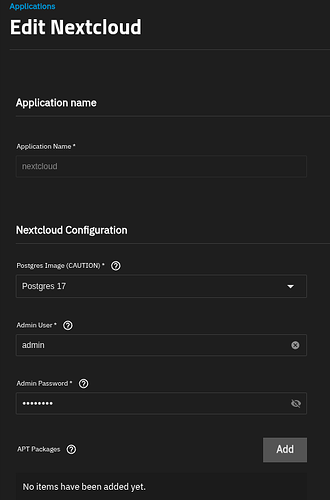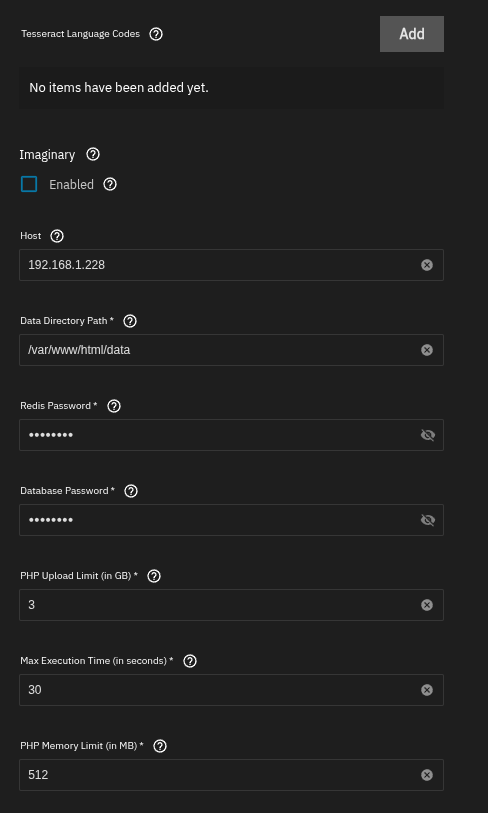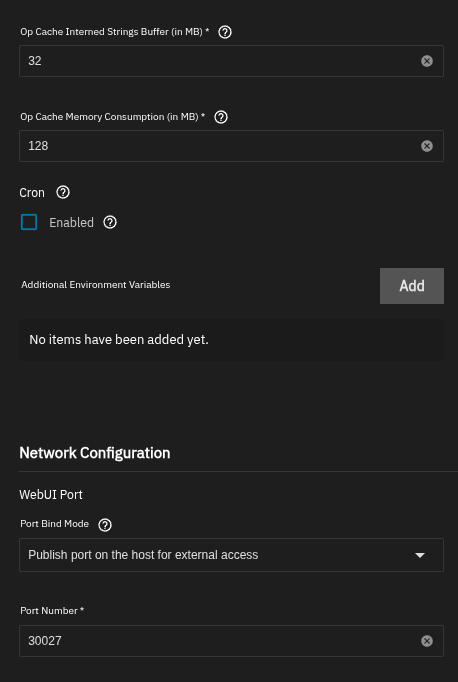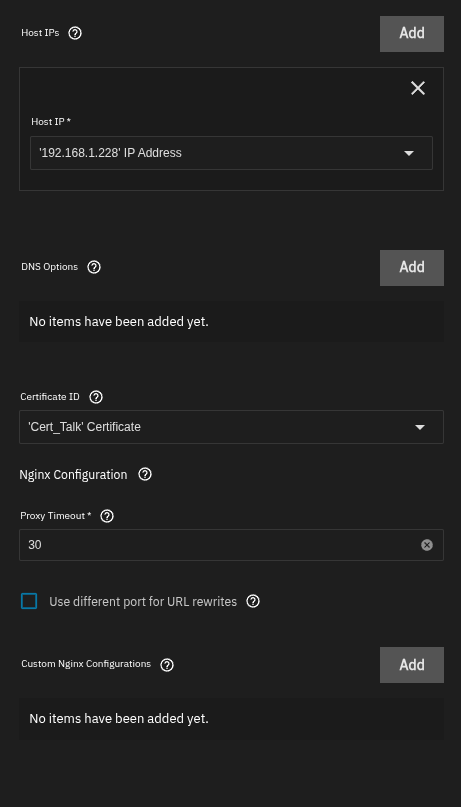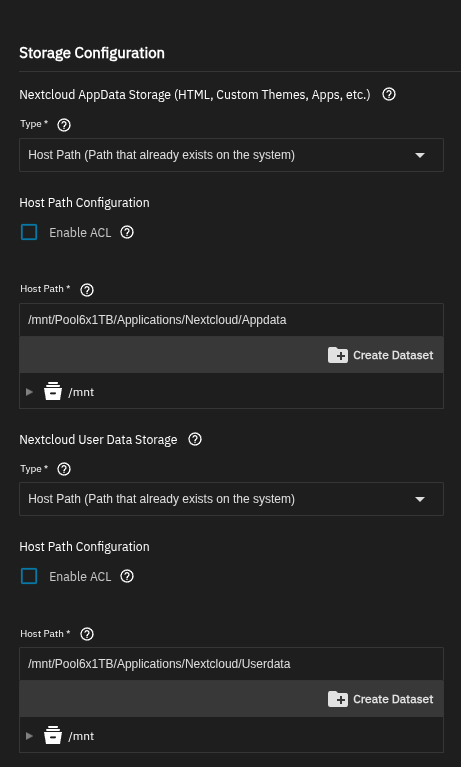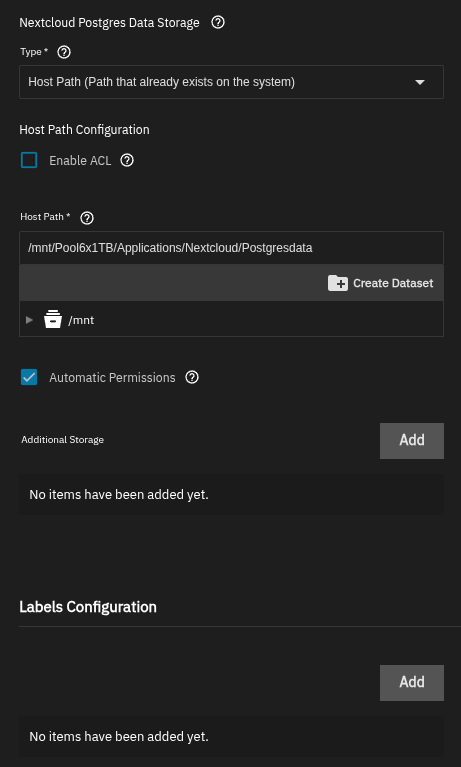Hola quisiera una aseoria de que camino seguir para resolver mi problema, primero les cuento como tengo instalado mi nextcloud y las configuraciones que tengo.
Tengo mi truenas el cual accedo a el de manera local con la direccion ip https://192.168.1.228 y dentro instalo nextcloud del catalogo y accedo mediante la ip https://192.168.1.228:30027 a continuacion les muesto la configuración dentro de truenas y tmb la configuracion de mi archivo config.php
<?php
$CONFIG = array (
'htaccess.RewriteBase' => '/',
'memcache.local' => '\\OC\\Memcache\\APCu',
'apps_paths' =>
array (
0 =>
array (
'path' => '/var/www/html/apps',
'url' => '/apps',
'writable' => false,
),
1 =>
array (
'path' => '/var/www/html/custom_apps',
'url' => '/custom_apps',
'writable' => true,
),
),
'memcache.distributed' => '\\OC\\Memcache\\Redis',
'memcache.locking' => '\\OC\\Memcache\\Redis',
'redis' =>
array (
'host' => 'redis',
'password' => '12345',
'port' => 6379,
),
'trusted_proxies' =>
array (
0 => '127.0.0.1',
1 => '192.168.0.0/16',
2 => '172.16.0.0/12',
3 => '10.0.0.0/8',
),
'upgrade.disable-web' => true,
'passwordsalt' => 'TvC+3hZ6reFd8YA0J2niMzroUyYTvY',
'secret' => 'dqZTS8K4FAHNBYNfOlvBCijsbrxY/4SU7VQ5XL8GlZA14l5c',
'datadirectory' => '/var/www/html/data',
'dbtype' => 'pgsql',
'version' => '31.0.9.1',
'dbname' => 'nextcloud',
'dbhost' => 'postgres:5432',
'dbport' => '',
'dbtableprefix' => 'oc_',
'dbuser' => 'oc_admin',
'dbpassword' => 'S8eB6PVokl21rlHq2mFr2x81l1PN0i',
'installed' => true,
'instanceid' => 'ochbzcy0v0jf',
'overwrite.cli.url' => 'https://192.168.1.228:30027',
'overwritehost' => '192.168.1.228:30027',
'loglevel' => 2,
'maintenance_window_start' => 1,
'default_phone_region' => 'MX',
'overwriteprotocol' => 'https',
'mail_smtpmode' => 'smtp',
'mail_sendmailmode' => 'smtp',
'mail_smtphost' => 'mail.xxxx.mx',
'mail_smtpauth' => 1,
'mail_smtpport' => '465',
'mail_smtpsecure' => 'ssl',
'mail_from_address' => 'correo',
'mail_domain' => 'xxxx.gob.mx',
'mail_smtptimeout' => 30,
'mail_smtpname' => 'xxxxx.gob.mx',
'mail_smtppassword' => '12345',
'trusted_domains' =>
array (
0 => '127.0.0.1',
1 => '192.168.1.228',
2 => '192.168.1.228:30027',
3 => 'localhost',
4 => 'nextcloud',
),
);
y con esas configuraciones ya tengo instalado nextcloud, entonces habilito talk dentro de nextcloud para acceder al panel de talk https://192.168.1.228:30027/apps/spreed/, entonces leo esta docuemtancion para configurar el motor de alto rendimiento y me baso en ello Quick install - Nextcloud Talk API documentation, pero el que sigo en realidad es este enlace How to configure talk HPB with Docker · nextcloud-snap/nextcloud-snap Wiki · GitHub dejando mi compose para mi motor de alto rendiemiento de esta manera
name: ‘hpb’
services:
nc-talk:
container_name: talk_hpb
image: ghcr.io/nextcloud-releases/aio-talk:latest
init: true
ports:
- 3478:3478/tcp
- 3478:3478/udp
- 8080:8081/tcp
environment:
- NC_DOMAIN=192.168.1.228:30027
- TALK_HOST=192.168.1.228:30027
- TURN_SECRET=caab86ee37253e031219182aaf3b214326c2bbfadda4bd5b76d796c0140ebbd5
- SIGNALING_SECRET=debc425db948b7658ce5bd83d4c2a374e5dcac202f7bfeb2b1f5ffe3dc277f82
- INTERNAL_SECRET=4962613579fc7ea92d86967087b623864fc7274cac05c0a442c06e9e7aafb9d9
- TALK_PORT=3478
- TZ=America/Mexico_City
restart: unless-stopped
una vez que creo mi contedor con ese compose, pruebo esto
root@truenas:/home/truenas_admin# curl http://localhost:8181/api/v1/welcome
{“nextcloud-spreed-signaling”:“Welcome”,“version”:“2.0.4~docker”}
root@truenas:/home/truenas_admin# curl https://localhost:8181/api/v1/welcome
curl: (35) OpenSSL/3.0.15: error:0A00010B:SSL routines::wrong version number
y por lo tanto al configurar mi motor de alto rendimiento falla diciendo esto
tambien trate de configurar el proxy nginx que viene dnetro de la instalacion de nextcloud en la opcion de Custom Nginx Configurations y agregando la ruta para mi arhcivo nginx-custom.conf basandome tmb en este enalce https://github.com/strukturag/nextcloud-spreed-signaling
tambien probe dentro del contendor para mi motor de alto rendimiento ahi configurar el nginx ya que el nginx que se instala con la aplicaicon de nextcloud dentro de truenas no me deja utilizar varios comandos esta limitado, entonces hice esto tambien
name: hpb
services:
nc-talk:
container_name: talk_hpb
environment:
- NC_DOMAIN=192.168.1.228:30027
- TALK_HOST=talk_hpb
- >-
TURN_SECRET=caab86ee37253e031219182aaf3b214326c2bbfadda4bd5b76d796c0140ebbd5
- >-
SIGNALING_SECRET=debc425db948b7658ce5bd83d4c2a374e5dcac202f7bfeb2b1f5ffe3dc277f82
- >-
INTERNAL_SECRET=4962613579fc7ea92d86967087b623864fc7274cac05c0a442c06e9e7aafb9d9
- TALK_PORT=3478
- TZ=America/Mexico_City
image: ghcr.io/nextcloud-releases/aio-talk:latest
init: True
ports:
- 3478:3478/tcp
- 3478:3478/udp
restart: unless-stopped
nginx-proxy:
container_name: nginx_hpb
depends_on:
- nc-talk
image: nginx:alpine
ports:
- ‘8443:443’
- ‘8080:8080’
restart: unless-stopped
volumes:
- >-
/mnt/Pool6x1TB/Applications/Nextcloud/custom/nginx-hpb.conf:/etc/nginx/nginx.conf:ro
- /mnt/Pool6x1TB/Applications/Nextcloud/Certificados:/etc/nginx/certs:ro
y entonces cree un nginx-custom.conf en el cual ya podia usar mas comandos quedando de esta manera
events {}
http {
server {
listen 443 ssl;
server_name 192.168.1.228;
ssl_certificate /etc/nginx/certs/CA_Local_Nextcloud.crt;
ssl_certificate_key /etc/nginx/certs/CA_Local_Nextcloud.key;
location /api/v1/ {
proxy_pass http://nc-talk:8081/api/v1/;
proxy_http_version 1.1;
proxy_set_header Host $host;
proxy_set_header X-Forwarded-For $remote_addr;
proxy_set_header X-Forwarded-Proto $scheme;
}
}
server {
listen 8080;
server_name 192.168.1.228;
location /api/v1/ {
proxy_pass http://nc-talk:8081/api/v1/;
proxy_set_header Host $host;
proxy_set_header X-Real-IP $remote_addr;
}
}
}
y probe y me resulto esto
root@truenas:/home/truenas_admin# curl -k https://192.168.1.228:8443/api/v1/welcome
{“nextcloud-spreed-signaling”:“Welcome”,“version”:“2.0.4~docker”}
root@truenas:/home/truenas_admin# curl http://192.168.1.228:8080/api/v1/welcome
{“nextcloud-spreed-signaling”:“Welcome”,“version”:“2.0.4~docker”}
y pruebo otra vez talk y me sale esto
Espero me pudieran orientar sobre que podria estar pasando y por que camino seguir poder solucionarlo, de antemano gracias
